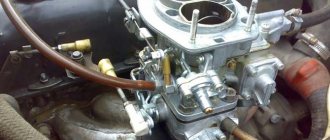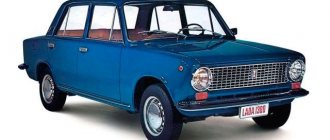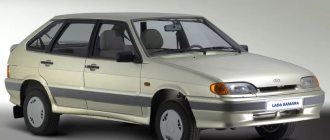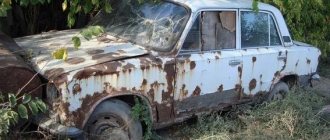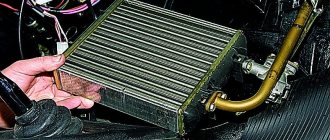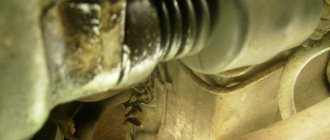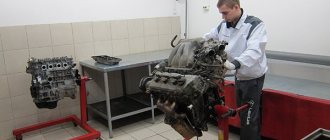Author: Lan, don’t growl
13 November 2015 14:08
Tags: 2101 Fiat AvtoVAZ Lada vases
8585
23
Critics of the domestic auto industry, who criticize it for borrowing, often lack understanding of how difficult it is not only to create a car from scratch, but even to make a “local” version of a finished model provided by a partner. Everyone knows that the VAZ-2101 has Italian roots and is an almost exact copy of the Fiat 124. The key word here is “almost”!
0
See all photos in the gallery
Refining a foreign car for harsh Soviet conditions was by no means limited to replacing nameplates, as one might think. Behind this word stood many years of work by testers and design engineers. A book could be written about the transformation of Fiat into Zhiguli, and within the framework of the article we will present several interesting facts from this story.
0
In the USSR of the “pre-Zhiguli” era, a personal (as they said then, private) car was more exotic than commonplace. It was not just a matter of price: operating the car was fraught with considerable difficulties, and it itself was too small to appear in every Soviet household. In the mid-sixties, the country's top party leadership decided to implement its own “people's car” project, but not a Soviet design, but a licensed one. And not because “there were no brains in the country of atom and space”: a machine that was competitive even “theirs”, thanks to exports, could help the country of the Soviets with the flow of foreign currency that is so necessary for the economy. In other words, the project was conceived with the initial aim “abroad”. In the USSR of the “pre-Zhiguli” era, a personal (as they said then, private) car was more exotic than commonplace. It was not just a matter of price: operating the car was fraught with considerable difficulties, and it itself was too small to appear in every Soviet household. In the mid-sixties, the country's top party leadership decided to implement its own “people's car” project, but not a Soviet design, but a licensed one. And not because “there were no brains in the country of atom and space”: a machine that was competitive even “theirs”, thanks to exports, could help the country of the Soviets with the flow of foreign currency that is so necessary for the economy. In other words, the project was conceived with the initial aim “abroad”. Fiat 124 (earlier modification)
Several options were considered as potential partners - primarily from “friendly” countries.
Was the original Fiat better than a penny?
We are sure that many motorists think that the VAZ-2101 car was simply copied from the Fiat-124 car model. This was done in order to establish mass production of VAZ cars as an alternative to Volga and Moskvich cars. But in fact, with a detailed comparison of the first Zhiguli model, you begin to understand how different our Russian “kopek” is from the original 124 Fiat.
In the Soviet years, our state tried to find a car basis on the basis of which it would be possible to create an affordable family car in the country, which could be produced in some city, which would allow the state to support this locality with cash income that would come from mass production cars. Among other things, such a search for a concept was as follows: the car had to be exported abroad. In addition, one of the main criteria was the following: such a car must be strong and reliable in order to withstand harsh climatic conditions and bad roads in the country, which in those days were quite common even in large cities of the vast Soviet homeland.
Fortunately for us, in the 60s the country of Italy was ready to sell its cars and ideas to anyone. As a result, the leadership of our country agreed with the Italians on the supply of equipment for the production of passenger cars under the VAZ brand based on the popular Fiat-124 car at that time. At the request of our country, Italian specialists, together with our engineers and designers, almost completely redesigned the project of the 124th Fiat model. Also, specialists personally came to the plant in Togliatti to set up and configure the equipment and also to teach the employees of the new automobile enterprise to produce products that they could later be proud of.
Reference: The Fiat-124 car was developed in the mid-60s by the Italian. The car was first presented to the public in 1966. In 1967, the Fiat 124 won the “Best European Car of the Year” competition. Judging by the reviews of critics and auto experts, the car was decent and of high quality. The only thing is that the design of the model was somewhat old-fashioned.
It is worth noting here that the leadership of our country has been looking for a suitable option for a long time, and precisely on the basis of some European car, to begin producing a Soviet car accessible to the people. Many options were considered, but due to the quality of Soviet roads, many good cars were crossed off the list for production, since the design of many European cars, and even in large numbers, could not withstand our harsh operating conditions.
Ultimately, the country's authorities settled on the Italian Fiat, which best met our Soviet needs. After signing an agreement with, our country acquired a license for mass production of Fiat-124 cars. This is how the people of the USSR saw the first model of the Zhiguli, that is, the VAZ-2101 (the export name of the car is LADA 1200).
Information about Fiat 124
According to generally accepted information, Fiat-124 is the general name of a whole family of passenger cars that were produced by the company of the same name from Italy from 1966 to 1982.
Main technical characteristics of this vehicle:
- Engine – in-line, four-cylinder.
- Transmission - four-speed, mechanical type.
- The body layout is front-engine with rear-wheel drive.
- Weight and dimensions:
- length – 4042 mm;
- width – 1625 mm;
- height – 1420 mm;
- wheelbase – 2420 mm;
- weight – 855-950 kg.
The general characteristics of the Fiat 124 include its classic layout:
- Front engine placement.
- The driving wheels are rear.
- Three-link rear suspension.
- Disc brake system (front and rear).
This Fiat model is considered the most successful mass-produced passenger car design in the history of the world automobile industry.
So, is our “penny” an exact copy of the Italian Fiat 124?
At first glance, you can certainly and certainly think that these are two identical cars. But a detailed comparison of these two machines immediately begins to reveal a completely different picture, which speaks of a huge difference in the design and technical data of the two machines.
When designing the first Zhiguli model, specialists changed many details of the original Fiat. Initially, the Soviet version of the Fiat-124 was called 124R. In 1968, the first prototypes of Zhiguli cars went out for testing.
And already in 1970, serial production of VAZ-2101 cars began.
How did our country manage to build a huge automobile plant practically from scratch and in such a record short time? The Italians also helped us with this, who provided us with a huge loan and personally participated in the design and construction of a modern automobile production facility at that time. The Italians also helped our authorities build the modern city of Tolyatti around the plant. By the way, this city was named after the Italian communist hero.
Of course, first of all, there was a lot of politics in the agreement between our country. After all, the Italian Government earned a lot of money from this deal. You can find many positive and negative reviews about the first Zhiguli model, but in any case, thanks to the agreement with the Italians, our country was able to build and launch one of the largest automobile production facilities in Eastern Europe for the first time. And the scale of production was really not small. For example, by the end of 1971, the first model of the VAZ-2101 car was already being produced in three shifts.
The first Lada model was not cheap enough (as the country's leadership initially planned), but nevertheless, many Soviet citizens could afford this model of car. Moreover, the “penny” was more reliable compared to the Fiat-124 (yes, this is true, although many people don’t believe it!), the car’s body was less susceptible to the same corrosion. In addition, the VAZ-2101 car was less demanding of the same fuel quality and had a number of other advantages over the same original. For example, the design of the machine was simpler, which allowed its owner to spend less money on its maintenance.
But despite the bright start of joint cooperation and the start of production of the first Lada models, the build quality of the cars was constantly changing. For example, the first models that were released from 1970 to 1972 were of the highest quality. But later the build quality decreased somewhat (especially in 1973). But since 1974, the quality of auto production has again reached its previous and acceptable level.
Unfortunately, starting from 1975, the build quality of the cars fell again. Ultimately, by the mid-80s, the quality of the “kopeck” cars produced was not much like those cars that were produced in the first years of the car plant’s operation.
First of all, the quality of cars began to decline due to the replacement of many Italian auto parts with Soviet analogues, which were certainly inferior in quality and had a large number of defects. In this strange way, the plant management tried to reduce production costs. Unfortunately, those who designed and produced Soviet auto parts did not have the necessary experience to produce reliable and high-quality auto components for cars.
Of course, those owners who drove the original Fiat 124 noted that Italian cars were more powerful and agile than the Zhiguli and had a better braking system. But as you already know, the VAZ-2101 car is a completely (from scratch) redesigned car, which in its design contains many of its own Soviet solutions. It is for this reason that it is simply stupid to compare these two cars with each other and say that the Italian Fiat is better than the same Lada. After all, 90% of all auto components of the “kopek” were unique at that time and had nothing in common with the same original (Fiat).
Let's, friends, leave the past and compare two beautiful models, two “classics” today. In the photographs you can see the original Fiat-124 (a rare early model produced in 1966) and the export model of the Zhiguli, which is called LADA 1200. The year of production of this “penny” is 1971. This car was released in the first year of full serial production of the first Lada cars. The two cars, as you can see, are perfectly preserved. They have original body paint and a virtually untouched and undamaged interior.
This comparison of the bestsellers of the two car markets is very important, since for 40 years the debate has not stopped about which car is better - the original or the copy?
Some of you will say that the original Fiat 124 car can accelerate to 170 km/h under certain conditions. But don’t rush, our Soviet “penny” is also not a timid one, it is also capable of accelerating up to 165 km/h. But the Fiat braking system must, of course, be much better. The Fiat car has a more masculine baritone engine sound compared to its Soviet counterpart, but nevertheless, the noise characteristics inside the cabin are almost indistinguishable. But the Lada car has a completely different engine sound and all this is due to the design features of the timing chain.
Some experts argue that the Fiat car holds the road much better, and the car’s suspension itself copes with various irregularities much easier, compared to the same “Zhiguli” of the first model. But this is still a subjective opinion and there is no official data on the difference in the behavior of the two cars on the roads. Needless to say, the braking system in an Italian car is much better than in a Zhiguli. There is no debate about this.
Now, dear friends, let's talk in more detail about the technical side of the Lada car. The VAZ-2101 is so different from the Fiat-124 that one gets the feeling that it was copied by aliens from outer space who did not have access to Fiat’s engineering drawings and designed this first Lada model based only on the appearance of the 124th model.
Pay your attention to the door handles of the two cars and the side mirrors. As you can see, the difference is obvious. Even the door hinges themselves have a different design, not to mention the lock of the triangular side window window. Comparing the interior of two cars, you can also find many differences and new engineering solutions.
For example, the first Fiat models had brown door trim, while the first VAZ-2101 models had a strictly black interior.
Even the ashtray in a Fiat car is located much closer to the driver than in the same Zhiguli. In our Soviet car, the car radio and volume control knob are located closest to the driver.
Continuing to compare the two cars and opening the hood of the cars, you can also see with the naked eye that there are also significant differences. Under the hood there are engines that are completely different in design.
For example, in a Fiat car the engine is much smaller in size than our Avtovaz engine.
Interesting to know if there are any differences in the trunk? As you can see, the trunk lock of the VAZ-2101 is more advanced. For example, the same trunk lock of a Fiat car can be opened using a knife, which can simply be inserted into the slot of the trunk lid. So we can say that Avtovaz engineers did a decent job of protecting the trunk from intruders.
By the way, the Fiat car has one unpleasant feature, which is the following, that is, the incomplete opening of the trunk lid, which greatly interferes with the driver when loading things into the trunk (Author's note: Poor shoulders of Fiat owners).
Also in the trunk of a Fiat (at that time) one could find a plastic suitcase with a set of tools for servicing and repairing the car. Instead of this suitcase, Lada received a tool bag and a pump.
If you lift two cars on a lift, then under the bottom of the cars you will not find many differences, but there are still some. By the way, the Lada car itself has only two special places for installing jacks, unlike the same Fiat car, which has four landing areas for lifting (jacking) the car. Therefore, in the photo itself you can see cars on different lifts. Looking at the cars from below, you can immediately notice that the Fiat has no engine protection at all. Upon careful examination of the car, a specialist can quickly determine that the Fiat is not much different from the Lada in terms of the same suspension design, the same axles and exhaust system.
Fiat-124 and VAZ-2101 (comparison from photo): external differences
If you look closely at the photographs of these vehicles, you can find the main differences in the appearance of both cars:
- door handles (recessed and convex);
- “fangs” on bumpers of various shapes;
- the front bumper is equipped with a hole for the handle (on the VAZ-2101);
- different chrome trim on the headlights;
- latches on windows of various configurations;
- internal hood reinforcements;
- trunk lid reinforcements (with and without holes);
- different design for holding the trunk lid;
- seats for rear suspension elements (struts are used on the Fiat 124);
- different locations of the jack socket;
- not the same stamping for the muffler pipe.
The simplicity of the design of the VAZ-2101 made it possible to spend less money on its maintenance and repairs.
So which car is better?
If we compare in theory, then this is certainly a Fiat-124, which has better brakes, a more modern suspension and is lighter in weight than the VAZ-2101, which makes the power-to-weight ratio of the car optimal. The steering in both cars is still similar, although the Lada is easier to drive. For example, when parking a car, the steering wheel of cars is very heavy, whether in Fiat or Lada. But at speed the steering wheel becomes light and does not cause any uncertainty in control.
But we must admit that Lada, during the design and development process, received many noticeable improvements in the technical area, although this does not allow this car to be better, since the power of our “kopecks” is significantly lower and differs from the same Fiat, the weight of the car is also more, and its fuel consumption is also much higher than in the Italian original.
However, this first Zhiguli model had enormous potential for its development at that time. But unfortunately, the policy in those years did not imply significant progress in future models. The maximum that the leaders of the Togliatti plant decided to do was to produce new models based on the same base of the first Zhiguli model.
So, friends, “ce la vie”, no matter how much we would like it, our Soviet “Lada 01” has never been better than the Fiat 124 car. But what is characteristic is that our “penny” was not so much inferior to many similar European cars of that time, which allowed our country to successfully sell cars not only in its domestic market, but also to successfully send large quantities of them for export.
The truth is that there will probably be experts in the world today who will try to prove to us the opposite, that our Soviet car model is much superior (better) to the Italian Fiat. We, dear friends, do not pretend to anything here. As they say, it's a matter of everyone's taste. So the discussion about which car is better than Fiat or VAZ continues.
Interior
But inside the car is very reminiscent of Mazda, but there’s nothing wrong with that, because the interior is still excellent. There are only two seats and not much space, that's why it's a roadster. The seats are upholstered in leather and, unfortunately, have little lateral support, but in principle it should be enough for normal driving.
Even the steering wheel remains the same, the only thing different is a different logo. The steering wheel itself is 3-spoke and has buttons for controlling the multimedia system. The column is covered in leather and is adjustable in both height and reach. The instrument panel is made up of three wells that house the 124 Spider's most basic analogue gauges.
The center console is not overloaded with anything; only the most basic things are located on it. A 7-inch touchscreen display of the Fiat Connect multimedia system is installed in the upper part. Below we are greeted by three large knobs that are responsible for the climate control system. At the bottom there is a small niche for small items.
The tunnel separating the driver and passenger received a large gearshift knob, after which we are greeted by a block with a washer and buttons for controlling the multimedia system. The mechanical parking brake lever is located in the same area. The final part received a long armrest.
Surprisingly, there is a trunk here, but its volume is encouraging - only 140 liters. The interior turned out great, but it’s a little disappointing that it’s not unique.
Characteristics
Show ▼ Hide ▲
Engines
| Name: | 2101 | 21011 |
| Fuel: | Petrol | Petrol |
| Volume: | 1,198 cm3 | 1,294 cm3 |
| Max. power: | 64 l. s., at 5600 rpm | 69 l. s., at 5600 rpm |
| Max. torque: | 87.3 Nm, at 3400 rpm | 94.3 Nm, at 3400 rpm |
| Max. speed: | 137 km/h | 140 km/h |
| Acceleration 0-100 km/h: | 23 sec. | 18 sec. |
Transmission:
| Mechanical: | 4 steps |
| Gear ratios: | |
| 1st gear: | 3,75 |
| 2nd gear: | 2,30 |
| 3rd gear: | 1,49 |
| 4th gear: | 1,00 |
| Reverse gear: | 3,87 |
Dimensions and weight:
| Length: | 4073 mm |
| Width: | 1611 mm |
| Height: | 1382 mm |
| Ground clearance: | 170 mm |
| Wheelbase: | 2424 mm |
| Front track: | 1349 mm |
| Rear track: | 1305 mm |
| Weight: | 955 kg |
And an unusual Italian
The rear suspension has undergone significant changes. The shock absorber changed its location, instead of the stabilizer that the Fiat 124 had, two short rods appeared, attached to the side members, the rear suspension became simpler and more durable. The front suspension has not changed fundamentally.
